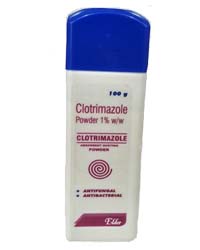Indications:
This medicinal powder is used in the prevention and treatment of the following symptoms and diseases:
- Fungal infection on vulva
- Fungal infection and skin irrtation on Penis
- Fungal infections in groin region
- Fungal irritaion and infection in vagina
- Fungal infections on and between toes
- Fungal infections on nappy rashes in children
- Fungal infections skin folds and armpits
Pharmacology:
Pharmacodynamic properties of clotrimazole:
Clotrimazole, an imidazole derivative with a broad spectrum of antimycotic activity, inhibits biosynthesis of the sterol ergostol, an important component of fungal cell membranes. Its action leads to increased membrane permeability and apparent disruption of enzyme systems bound to the membrane. Clotrimazole are used together to treat cutaneous tinea infections. In studies in fungal cultures, the minimum fungicidal concentration of clotrimazole caused leakage of intracellular phosphorous compounds into the ambient medium with concomitant breakdown of cellular nucleic acids, and accelerated potassium etflux. Both of these events began rapidly and extensively after addition of the drug to the cultures. The primary action of clotrimazole is against dividing and growing organisms.
Mechanism of Action:
Clotrimazole interacts with yeast 14-α demethylase, a cytochrome P-450 enzyme that converts lanosterol to ergosterol, an essential component of the membrane. In this way, clotrimazole inhibits ergosterol synthesis, resulting in increased cellular permeability. Clotrimazole may also inhibit endogenous respiration, interact with membrane phospholipids, inhibit the transformation of yeasts to mycelial forms and the uptake of purine, impair triglyceride and/or phospholipid biosynthesis.
Pharmacokinetic properties of clotrimazole:
Absorption:
Poorly and erratically absorbed orally, minimal vaginal or topical absorption
Protein Binding:
90%
excretion:
Pregabalin is eliminated from the systemic circulation primarily by renal excretion as unchanged drug.
Metabolism: Hepatic (metabolized to inactive metabolites).
Pregnant and Lactating
Please consult your doctor or a healthcare expert before starting this medicine during pregnancy.
Contraindications:
Hypersensitivity to the active substance or to any of the excipients.
Side Effects:
Though very rare but some of the reported side-effects of this include:
- Bowel discomfort
- Upset stomach
- Hypersensitivity
- Itchy rashes
- Blisters
- Itching or burning
- Skin irritations
- Peeling or flaking of the skin
- Pain or burning or stinging sensations
- Swelling
